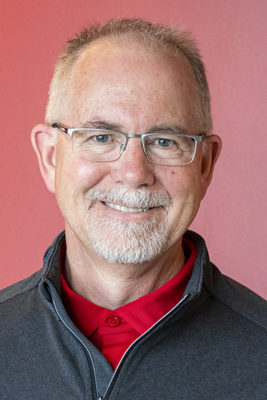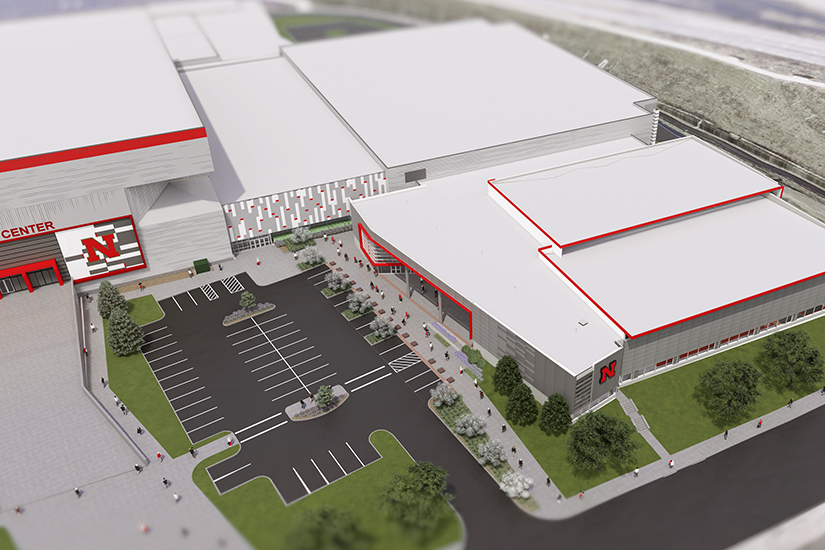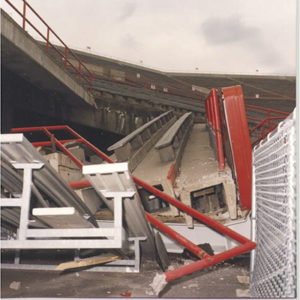|
Getting your Trinity Audio player ready...
|
Nebraska football players tap the horseshoe above the doors leading into Memorial Stadium for the famous Tunnel Walk, a tradition going back to 1994. At the northwest corner, they gather at the entrance with head coach Scott Frost to take in the roar from Sea of Red before running out into the field.

Memorial Stadium has seen many expansions, improvements, and innovations since its construction in 1923, and it boasts 375 consecutive sellouts going back to 1962. The stadium might be the most recognizable venue at Nebraska, but the university hosts other industry-leading facilities for all student athletes.
Since joining the Nebraska Athletic Department in 1993, John Ingram has overseen the planning, design, and construction of more than $500 million in construction projects. And innovation is the name of the game.
Nebraska was the first to have big screens in a college stadium and an on-site video production studio, as well as the first to have field turf, which is now the standard artificial athletic surface. The school was one of the first to have a field level suite before it became fashionable. For the national championship, the volleyball team and alternate court was developed to use for important matches utilizing a removable court system. For the national champion bowling team, Ingram led the implementation of a new product coming from Germany: pins on strings, which had 20 percent of the moving parts of a typical pin setter and provided a better ability to set up spares to help the team train.
“We’re not here to copy other people and just do what other people are doing,” explains Ingram, the associate athletic director for capital planning and construction. “We’re trying to think of what’s coming in the next five years, ten years, and trying to go there when we develop our new facilities, so we are ready for the future when we open the doors.”
Passing of the Torch
An Ingram has been working on Memorial Stadium since 1962, the year the sellout streak started. Ingram’s father worked with the facilities management department, which also took care of all athletic facilities. Since around the age of five, Ingram has been around Memorial Stadium. He followed his dad around on game days, going out with him on calls.
Ingram’s father retired in 1993—the same year Ingram joined the athletic department. “I didn’t realize it at the time when I first took the job,” he says, “but the torch was kind of passed on.”
There hadn’t been any real work done on the stadium in years, and on May 17, 1993, the southeast corner of the stadium collapsed. A structural team was brought in to do an analysis and when Ingram was hired that fall, he picked up where the university facilities management team had left off and developed a long-term plan to take Memorial Stadium into the 21st century. $25 million in repairs were made to the stadium with repairs to the endzone structures, and 30 percent of the original concrete was replaced on the original 1923 stadium. The stadium bowl was then waterproofed with an elastomeric coating.
One of his first big projects was the west stadium expansion project, which added 42 suites and a new press area in 1999. “That was a big learning curve, but it was very satisfying in the end,” Ingram explains. “We finished it a week before the kickoff for the first game in 1999. It really educated me on how projects—major projects—work and are delivered in a college athletics setting.”
He adds, “Kickoff dates are set and don’t wait for you to finish the project.”

Nebraska Goes Big
Next on the horizon is the “Go Big” project, which was announced in the fall of 2019. The $155 million athletic complex, constructed north and east of Memorial Stadium, will provide convenience and benefits to all 600-plus student athletes as well as the fan experience with new vertical transportation modes for fans entering and exiting North Stadium.
The 350,000-square-foot facility will provide the football program with a new locker room, strength and conditioning center, athletic medicine facility, equipment room, meeting rooms, coaches’ offices, and an additional outdoor practice facility. Because of its intended location, the Ed Weir Track, the Go Big plan also includes constructing a new outdoor track stadium north of the Bob Devaney Sports Center, home of the volleyball team.
The complex will also include a training table and academic support facilities for all student-athletes, regardless of sport. “We probably develop athletes more than other schools,” Ingram says. “Nebraska has been the pioneer in the areas of academic support and nutrition nationally.”
Athlete development is a tradition established way back when Tom Osborne was head coach, he adds. “In our walk-on program with football, we might not get our share of five-star athletes, but we’ll take three-star athletes and turn them into a five-star throughout their career at Nebraska because of our innovative ways to develop the student athlete.”
In 1969, Nebraska was the first university to hire a full-time strength coach, Boyd Eppley. “We set the standard with strength and conditioning,” Ingram says. A lot of the equipment in the strength complex since then, he explains, has been designed on campus and that continues today—some of which Ingram cannot speak about just yet.
When it comes to leading these large projects that ultimately impact the student athletes’ experience, Ingram includes a focus group of student athletes. In February 2020, the gymnastics team moved into its new 42,000-square-foot home, which has training rooms, locker rooms, large gym spaces, more equipment, a hydraulic system, and offices for both the men’s and women’s teams.
“When you see the faces of those kids, when they walk into that new facility, that’s the crowning moment,” Ingram says. “After the hours of planning and working with contractors and working through the issues, that makes it all worthwhile.”
Gather ‘Round the Table

In 2019, Nebraska saw $1 billion of damage after heavy rainfall and rapid snowmelt caused catastrophic flooding across the Missouri River Basin. As an amateur woodworker, John Ingram saw an opportunity to make dinner tables for flood victims after conversations over Easter dinner.
“As I was reflecting, I just came up with the idea,” Ingram explains. “I’ve got wood. I’ve got some talent. Maybe I can inspire other woodworkers, and we can make dining tables for flood victims.”
So he created the Reclaim, Rebuild, Restore Project to help flood-stricken families, partnering with Habitat for Humanity in Omaha and Nebraska Innovation Studio to not only make the tables but also deliver to families as they moved back into their homes.


